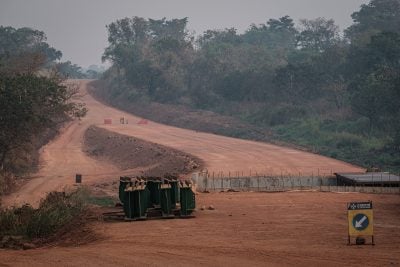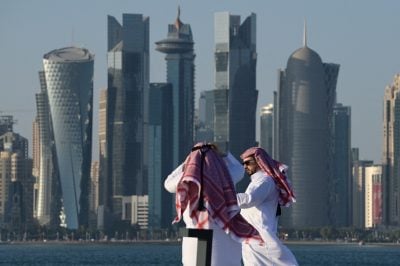The march from rural Africa to urban centres is relentless and accelerating by the year. Cities are both becoming denser as well as expanding outwards while brand-new satellite towns and cities are springing up. Cities have always been wealth creators and crucibles of change but they can also become hellish places to live in. Managing cities has now become the first policy priority for African governments and civic authorities. Given the advances made in the design of cities and the technology that can be deployed to enhance urban space, can Africa leapfrog the usual development pattern and go straight into the best the 21st century has to offer? Report by Neil Ford.
African cities can appear chaotic at the best of times. Poor infrastructure and limited transport services often exacerbate the impact of poor city planning and waste management, while rapid urbanisation and migration flows threaten to swamp attempts to impose order on informal housing.
Yet a decade of strong economic growth on the continent has generated a more optimistic mood – with governments and planners daring to dream of a better future for their citizens.
About 430m people now live in African cities, about 42% of the continent’s population, and this figure is growing by an average of 3% a year. That is 13m new urban residents every year, partly because of natural population growth but also because of migration.
Cities have always been wealth creators and crucibles of change but they can also become hellish places to live in.
This is very rapid urbanisation by most standards, although slower than in China, with which the African experience is most often compared. There is, however, a big difference in the way that urbanisation is happening in the two regions.
Beijing’s support for rural-urban migration and the creation of tens of millions of new manufacturing jobs in the industrialised south and east of China saw most people move directly from rural locations to huge cities.
Where governments allow the market and socio-economic trends to dictate, migration does not tend to take this form. Unlike in China and much of South-East Asia, sub-Saharan Africans are not flocking to vast manufacturing centres in the cities. Most African migration is from rural areas to small towns, from small towns to big towns; and from big towns to cities.
Most people do not migrate directly from a rural setting to Lagos, Kinshasa or Dar es Salaam. As a result, much more attention needs to be paid to the development of smaller African towns.
It is easier to provide services and infrastructure to people in dense concentrations, but the focus on urban areas could also benefit the wider population. New African urban developments have little room for the traditional small plot of land to grow food for an individual family.
The new African middle classes are living an international urban lifestyle that is more curtained off from their rural roots, but they still require food and so the demand for food production in rural areas will rise quickly over time. This should help to transfer some of the new-found urban wealth to rural areas.
Nevertheless, it is clearly worth comparing the situation in Africa’s biggest cities with that of their Chinese counterparts. The two regions will soon have the same populations, both are urbanising very quickly and both are attempting to do so while simultaneously revolutionising their economies.
In 1980, the proportion of Chinese people living in cities was about 18% and the vast majority lived a rural lifestyle. Only Beijing and Shanghai had more than 5m residents. Thirty years later, there were more people in cities than in the countryside and 16 cities had more than 5m inhabitants.
China has experienced the biggest mass migration in human history over the past three decades, as people have flocked to the cities with the backing of the government.
In The State of African Cities 2014: Re-imagining sustainable urban transitions report, the deputy executive director of UN Habitat, Dr Aisa Kirabo Kacyira, argued: “Africa is transitioning towards a whole new socio-economic and political landscape through rapid urbanisation driven by massive population growth. But urban infrastructures, services, and land markets, as well as the urban economies, cannot absorb the newcomers to the cities, whether large or small.”
One of the biggest problems in attempting to get a handle on urbanisation is the lack of reliable statistics. Estimates of Lagos’s population vary from 12.6m, which the UN regards as accurate, up to 22m, although it is generally recognised to be the seventh fastest-growing city in the world. The UN’s upper population prediction for Nigeria by 2100 is an incredible 730m, which would be more than the entire population of Europe by the same date. Tanzania is forecast to have 440m inhabitants and the figures for other African countries are similarly startling. The majority of these will be urban residents; indeed the number of people living in African cities is expected to triple over the next 40 years.
While Chinese urban developments focus on providing homes for the masses, the idea of the smart city is gaining traction. As we discuss later, the city of Lagos is attracting interest for its smart technology potential, but Rwanda too is often cited by international organisations as a model for promoting technology and smart solutions; while the South African government also talks a great deal about smart services and connectivity.
New cities
Angola has collated several global approaches and added its own African twist as it sets out to realise the government’s ambition to build a million new affordable homes by 2017. The majority of the country’s population already lives in cities – driven there partly by the 25-year civil war, which finally ended in 2002.
Developing smart cities will require citizens to buy into the concept but African IT firms need to play their part. World Bank research has identified almost 100 technology hubs on the African continent. One of the largest is so-called Yabacon Valley, the Lagos suburb of Yaba that hosts dozens of IT firms, plus banking and university centres.
Interest in African smart cities is growing on the back of new city developments, such as Eko Atlantic in Lagos, the revamped Tatu City project in Nairobi, Angola’s Novas Centralidades (Portuguese name for New Centralities) and a dozen similar ventures in all parts of the continent. While termed ‘new cities’, each of these is actually planned or under development on the edge of Africa’s biggest existing cities.
It could be argued that existing urban planning and development on the continent has largely failed. Martin Sagar, partner and head of master planning at Sheppard Robson, says: “Inevitably, cities are under constant need of revision and repair and this is a global issue that is not exclusive to Africa. However, traditionally, in developed countries, cities have grown in a manageable way; however, the rate of change in some African cities is much faster, making the case for new cities more compelling.”
The high-profile Eko Atlantic project is being developed by South Energyx Nigeria on land reclaimed from the sea. Developers are keen to point out that the area of new land will be about the same size as Manhattan, no doubt with the aim of marketing the project as an African version of central New York.
The centrepiece of Eko Atlantic will be a new central business district (CBD), the first phase of which will include six towers to be set around a large open public space. It will provide 2.8m square feet of leisure, office, residential and retail space on the part of the CBD closest to Victoria Island, with the aim of connecting Eko Atlantic to the rest of Lagos as quickly as possible.
A wide boulevard is to be provided through the centre of the project, helping to divide the CBD into a grid with 12 main plots. The planned population of 250,000 for the whole project makes it one of the most ambitious urban schemes in Africa. As on all such projects, there is a risk that the scheme could be divisive, by creating modern, prosperous and possibly gated enclaves that have too little economic and social connection with surrounding areas.
At present, 60% of the population of Lagos lives in informal settlements. Sagar commented: “These communities generate little tax revenues so little funding is available for infrastructural improvements on a big scale, making new cities – with their own revenue streams – an attractive proposition. However, building new cities is not the only option for improving these informal communities.
“We’re working with Water Aid in Lusaka, Kinshasa, Lagos and Maputo on designs that explore ways of radically refurbishing existing infrastructure under the direction of a spatial master plan which incorporates existing communities rather than literally building over them, which is too often the case.”
He added: “You can’t solve fundamental social division through master planning but we can find ways of addressing imbalances. For example, there can be ways of using revenues created by developments to fund social and educational projects.”
Luanda, the capital of Angola, is taking a different approach; while dozens of brand-new glass and steel structures are going up rapidly around the bay area, the province’s urban planners are working on a massive project they describe as ‘relocation in situ’ – shifting one of the continent’s biggest slums into new low-cost housing while developing the vacated central area into a ‘garden city’ similar to the project in Singapore.
Transport arteries the key
It is worth considering the definition of a city. Some urban centres in southern China have claimed to be the biggest cities in the world but they are not genuine cohesive cities but rather urban sprawls.
The generally accepted definition of a city in planning terms is a conurbation where it is feasible for residents in all areas to travel to work on a daily basis to all other parts of the centre. It can take two days to travel across some Chinese urban areas and so they are not considered to be individual cities.
This is a lesson worth learning for many African cities. If they are to be economically viable centres, then they must ensure that transport around them is as quick and reliable as possible.
Cars can play a role in this equation but public transport is vital, whether through dedicated bus lanes, urban trains, underground systems or trams. At present, South Africa and much of North Africa has begun to tackle the issue but even here far more needs to be done. In the vast area in between, how will Kinshasa, Nairobi, Dar es Salaam, Luanda and Accra cope when they have 10m, 20m or even 30m residents?
However, there is much that African cities can learn from their Chinese counterparts, many of which have grown even more quickly, and this will be considered later.
It is particularly difficult to develop modern public transport systems within already huge African cities where public transport is generally informal. It can, however, be achieved. Sagar comments: “Rising road traffic is one of the biggest obstacles to delivering major sustainable transport improvements as it is a self-perpetuating problem. More specifically, the challenge is encouraging people to not use their car and favour public modes of transport.
“Historically, the introduction of major public transport schemes has been fraught with difficulty and has historically been most easily implemented in non-democratic societies.”
It is difficult to impose transport, power and water infrastructure on existing urban landscapes, so it helps if investment can be joined up. For example, a new ring road has been proposed for Lusaka that would be integrated with a new water and sanitation system.
In Kinshasa, green corridors are being considered that would incorporate drainage channels, which would help to protect the city from flooding. While South African firms such as Murray & Roberts and WK Construction are active in their own country and elsewhere on the continent, much of the work is carried out by non-African contractors.
Chinese construction firms were working on $40bn worth of contracts in Africa in 2012, equivalent to 35% of all Chinese construction projects taking place anywhere outside China. This level of investment is clearly welcome but Chinese developers tend to work with Chinese subcontractors, making far too few links with local companies and putting too little effort into helping to build capacity among them.
While Chinese construction firms dominate the industry in Angola, scores of Brazilian, Portuguese and British firms are also active. Odebrecht is perhaps the best-known Brazilian firm in Angola, while the big construction contracts on Ethiopia’s various large hydro schemes are being undertaken by Italian and Chinese firms.
However, there are signs of growth in the African construction sector. South African developer Atterbury and Ghana’s Social Security & National Investment Trust are the two biggest investors in the new West Hills Mall in western Accra.
The shopping mall, which opened at the end of October, provides 27,500 square metres of retail and restaurant space, all of which has already been let, although a further 12,154 square metres is to be provided in Phase 2. The interchange that provides access to the mall from the highway has been constructed by another Ghanaian company, High Brains Construction.
It is worth pointing out that Phase 1 was completed on schedule in a very ambitious 22 months. Two similar shopping centres are already under development in Ghana: in Kumasi and Achimota.
Africa’s cement production capacity is set to double over just five years, paying testament to the rapid rise in construction activity and growing demand from both African and non-African construction companies. Chinese and other foreign sources are funding some landmark buildings but much of the demand comes from smaller housing schemes that attract far less attention.
Want to continue reading? Subscribe today.
You've read all your free articles for this month! Subscribe now to enjoy full access to our content.
Digital Monthly
£8.00 / month
Receive full unlimited access to our articles, opinions, podcasts and more.
Digital Yearly
£70.00 / year
Our best value offer - save £26 and gain access to all of our digital content for an entire year!
 Sign in with Google
Sign in with Google 


